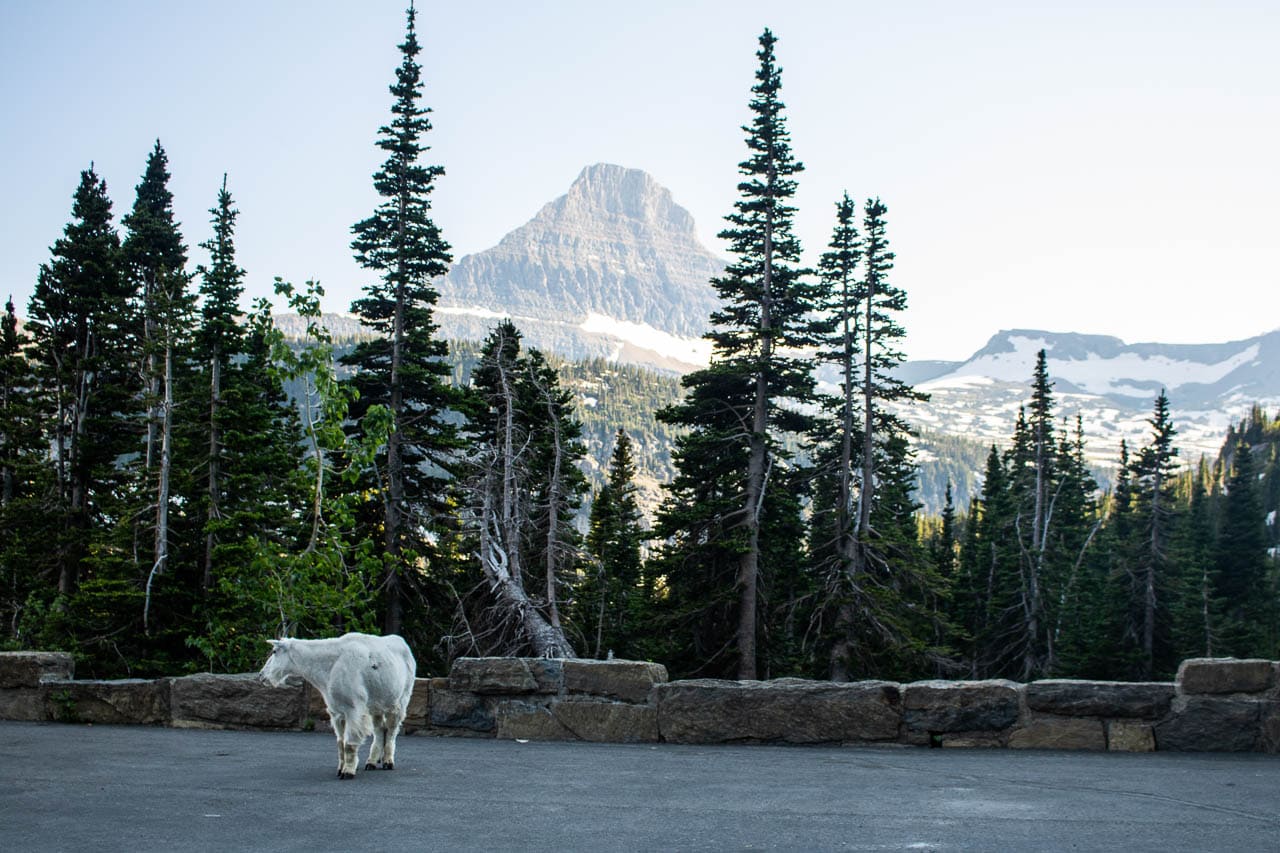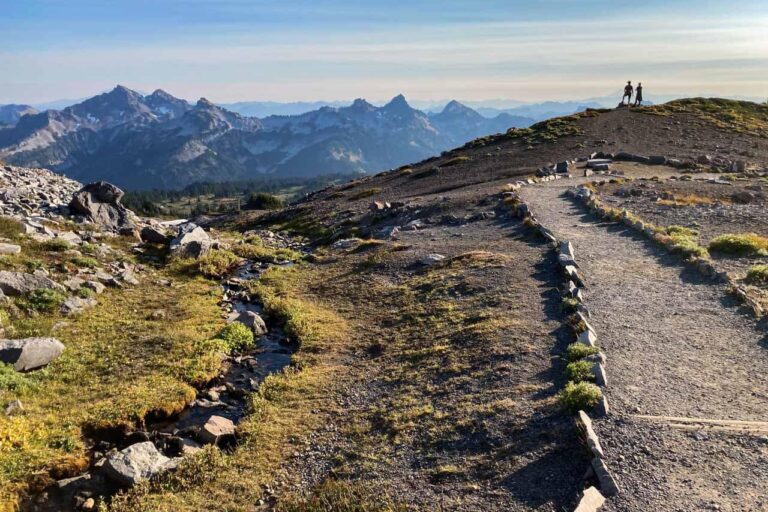5 Best Places to See Wildlife in Glacier National Park
Just like other national parks in the Rocky Mountains, particularly Yellowstone and Grand Teton, Glacier National Park is a haven for wild animals. The diverse landscapes of forests and meadows, alpine areas and lakes provide excellent habitats for all kinds of wildlife in Glacier National Park.
In this Glacier National Park wildlife watching guide, you’ll learn which animals you can see, where you can see wildlife in Glacier, and how to stay safe when recreating in wildlife country.
Glacier National Park Wildlife Viewing Guide
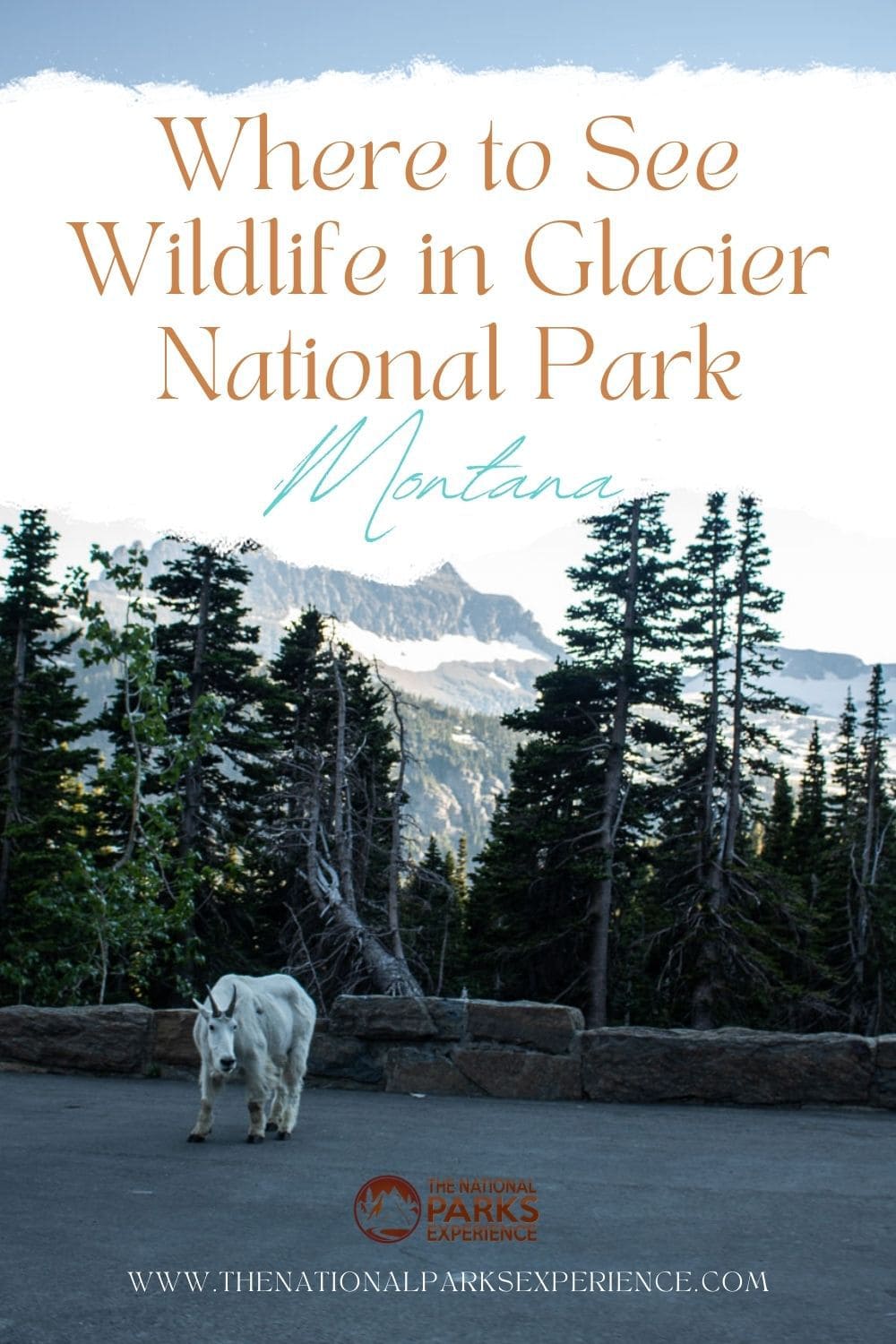
One of the best U.S. national parks to see wildlife, Glacier National Park is home to almost all of its historic species.
After gray wolves migrated back into the park from Canada in the late 1980s, there are now only two original species missing: the American bison and woodland caribou.
There’s a reason Glacier National Park is a UNESCO Biosphere Reserve. An ecological stronghold in the heart of North America, the park positively teems with wildlife. It’s part of the Crown of the Continent Ecosystem, one of the largest intact ecosystems in the United States, home to a wealth of iconic American mammals.
From both black and grizzly bears to wolves and wolverines to moose, mountain goats and bighorn sheep, you can see lots of amazing animals in Glacier National Park.
This post about Glacier National Park wildlife viewing contains affiliate links. You can read more about our Terms of Use / Disclosure here.
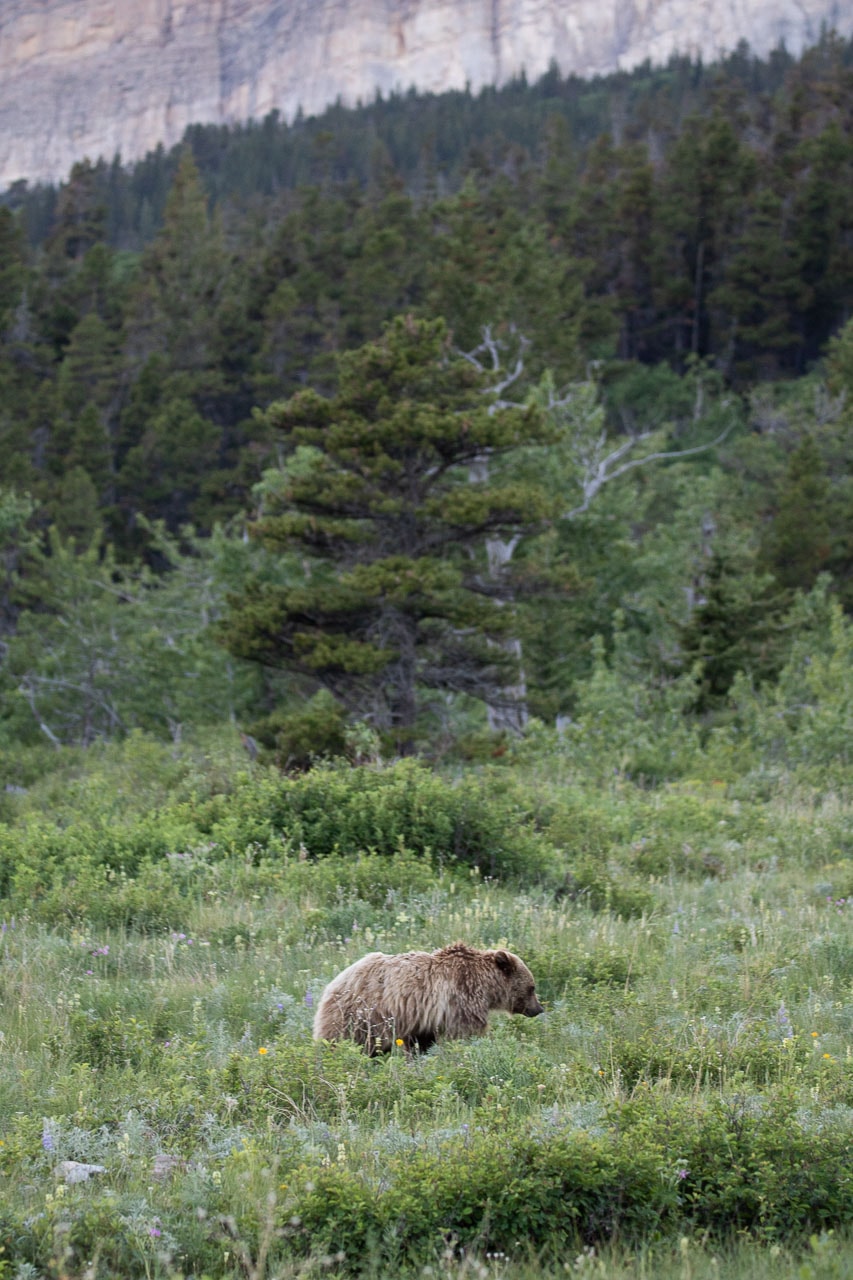
Iconic Animals to See in Glacier National Park
Here’s a list of the most high-profile wildlife (mammals) you can see in Glacier National Park. I’ve included the best places to see each specific animal in the park (as well as how likely you are to see one).
Note that some animals are very abundant and almost guaranteed to be seen, while others are uncommon to rare.
Some species, although present, aren’t seen even by people who spend years, if not decades, living in or visiting the park.
For example, I can promise you that you’ll see bighorn sheep and mountain goats if you spend a couple of hours at and around Logan Pass in the morning and/or evening.
On the other hand, there are only about 50 wolverines in Glacier National Park. Even though that means Glacier has the densest wolverine population in the contiguous United States, your chances of actually seeing one of these shy and elusive animals are exceptionally low.
Iconic Mammals in Glacier National Park
- Grizzly bears – Logan Pass, Hidden Lake, St. Mary Lake, Many Glacier Road, Many Glacier trails (common)
- Black bears – Avalanche Lake Trail, St. Mary Lake, Many Glacier Road, Many Glacier trails (common)
- Gray wolves – Lower McDonald Creek, North Fork area and along Camas Road (rare)
- Moose – Lake McDonald, St. Mary Lake, Swiftcurrent Lake, Lake Josephine, Fishercap Lake and Two Medicine Lake (common)
- Bighorn sheep – Logan Pass, Hidden Lake, Iceberg Lake and Grinnell Glacier (very common)
- Mountain goats – Logan Pass, Hidden Lake, Iceberg Lake and Grinnell Glacier (very common)
- Elk – Two Dog Flats and St. Mary Visitor Center area (common)
- Wolverines – high-elevation areas such as the Highline Trail, Piegan Pass, Siyeh Pass, Swiftcurrent Pass, Grinnell Glacier and Iceberg Lake (extremely rare)
- Pika – high-elevation areas such as the Highline Trail, Piegan Pass, Siyeh Pass, Swiftcurrent Pass, Grinnell Glacier and Iceberg Lake (uncommon)
Iconic Birds in Glacier National Park
In addition to these large (and small) mammals, Glacier National Park is also home to more than 260 species of birds. A remarkably high number considering how far north the park is, this is due to Glacier’s extensive patchwork of diverse habitats, from aquatic and riparian to terrestrial.
When visiting and exploring Glacier, watch for iconic birds like American dippers, bald eagles, osprey, common loons, hummingbirds, woodpeckers, ptarmigans and harlequin ducks.
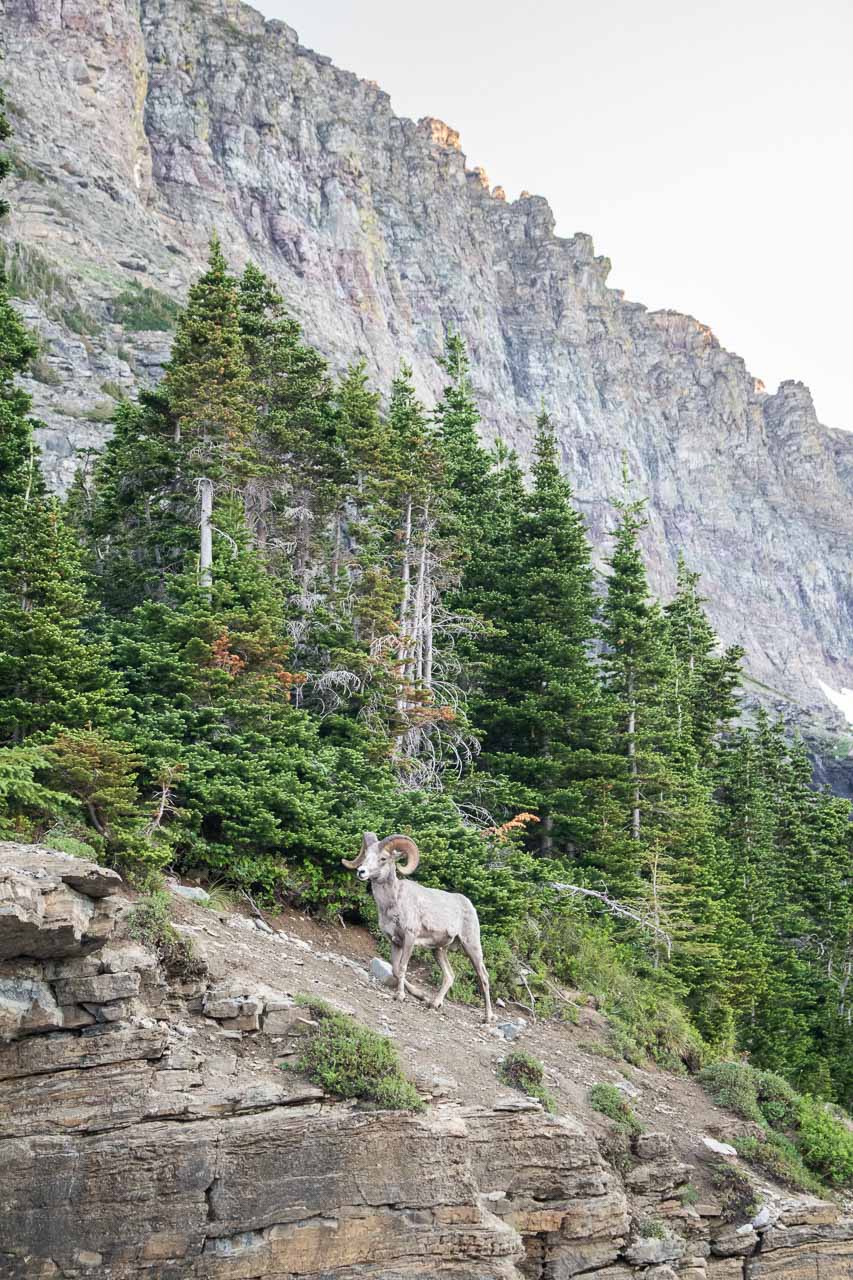
Where to See Wildlife in Glacier National Park
You can run into a wild animal literally anywhere in the park, from parking areas and campgrounds to trails, overlooks and even on lakes.
It’s not because a place is crowded that animals would necessarily avoid it. Logan Pass is the perfect example of that—more about that below.
Mountain goats wander across parking lots, grizzly bears lumber through meadows and campsites, moose aloofly stand on roadsides, and bighorn sheep share trails with hikers. Encountering wildlife in Glacier National Park is one of the park’s greatest attractions and experiences.
Also, it’s the ease with which you can see so much Glacier National Park wildlife that serves as a reminder that we are visiting their home.
Animals rule the land here, and they sometimes act like it. I’ll talk more about wildlife safety at Glacier at the end of this post.
Now, let’s continue with the best places to see wildlife in Glacier National Park. In my personal experience, the best chances of seeing a variety of animals are at the following locations:
- along the highest part of the Going-to-the-Sun Road (around Logan Pass);
- on high-elevation hiking trails (Highline, Hidden Lake, Iceberg, Grinnell Glacier,…); and
- in the valleys of the park’s east side (St. Mary and Many Glacier).
The following are, in my opinion, the five best places to see Glacier National Park wildlife.
Logan Pass
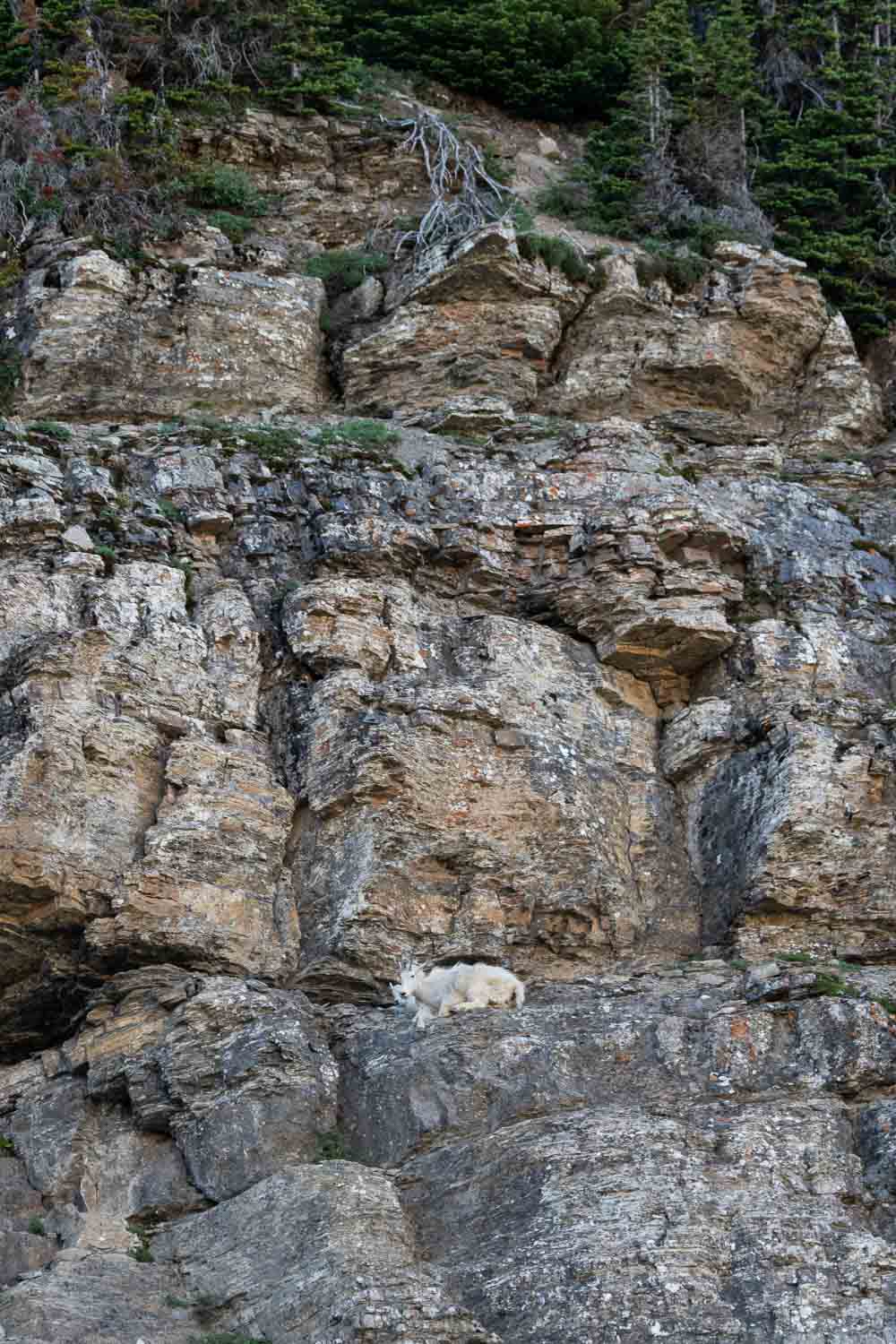
The highest point (6,646 feet) and one of the main highlights of the Going-to-the-Sun Road, Logan Pass is in the heart of the park. It’s also one of the busiest places in Glacier.
In summer, especially in July and August, the parking lot at the Logan Pass Visitor Center is almost always completely full between 8 am and 4.30 pm. Luckily, if you’re here to see Glacier wildlife, you should be here either before 8 am or well after 4.30 pm.
Get here at or before sunrise or about an hour before sunset for the best wildlife viewing opportunities. That’s also when you’re most likely to find a parking spot.
Early in the morning and late in the evening, Logan Pass is a great place to see bighorn sheep and mountain goats, even though they are present in this area all the time.
Visit the Oberlin Bend Overlook for excellent mountain goat spotting, or scan the meadows and slopes below the east end of the parking lot for bighorn sheep. You can also see these animals along the Going-to-the-Sun Road, just east of Logan Pass.
Additionally, Logan Pass, with its sprawling alpine meadows and stands of trees, is also prime grizzly bear habitat. It’s not unusual to see a grizzly meandering or across a meadow or along a slope.
Hidden Lake Overlook Trail
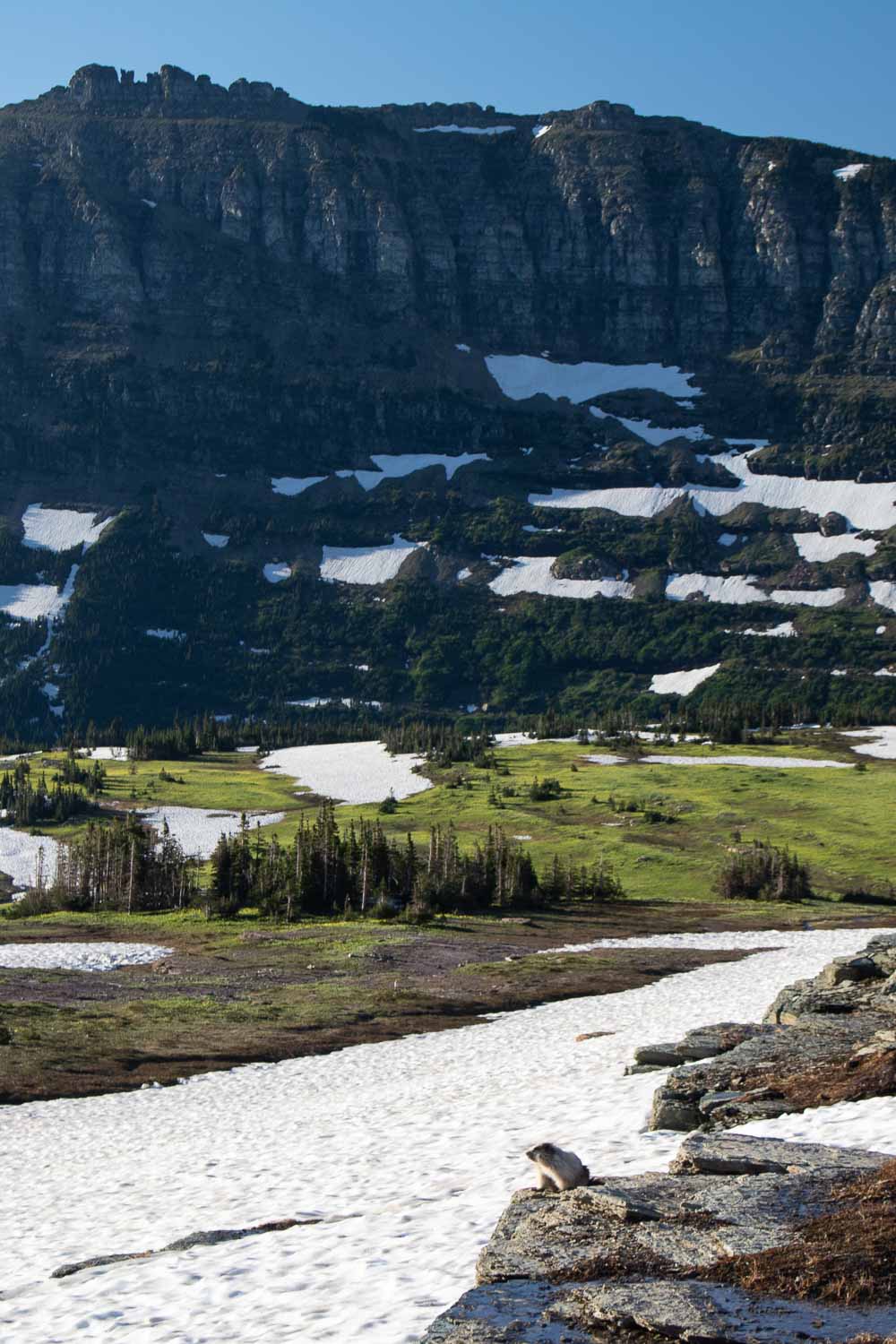
Technically a part of the Logan Pass area, but well worth discussing a bit more, the Hidden Lake Overlook Trail is arguably the best short hike in Glacier National Park to see wildlife.
It’s one of my favorite places on the Going-to-the-Sun Road.
Similar to Logan Pass itself, this trail offers amazing opportunities to see bighorn sheep and mountain goats. Hikers can see sheep on the boulder-covered slopes of Clements Mountain, while mountain goats regularly roam the area around the Hidden Lake Overlook itself.
As I mentioned above, this area is known for its grizzly bears. The Hidden Lake Overlook Trail runs straight through the bears’ habitat, making this one of the best hikes to see grizzlies in Glacier National Park.
In fact, grizzly bears are so common here, especially in summer, that park management occasionally closes the trail temporarily to protect both the bears and visitors.
In addition to sheep, goats and bears, the Hidden Lake Overlook Trail is also a nice spot to see some of Glacier National Park’s smaller mammals.
Keep your eyes peeled for the tiny and cute, but rather loud, pikas. Rodents like voles, chipmunks, ground squirrels and marmots are common here as well.
St. Mary Lake North Shore
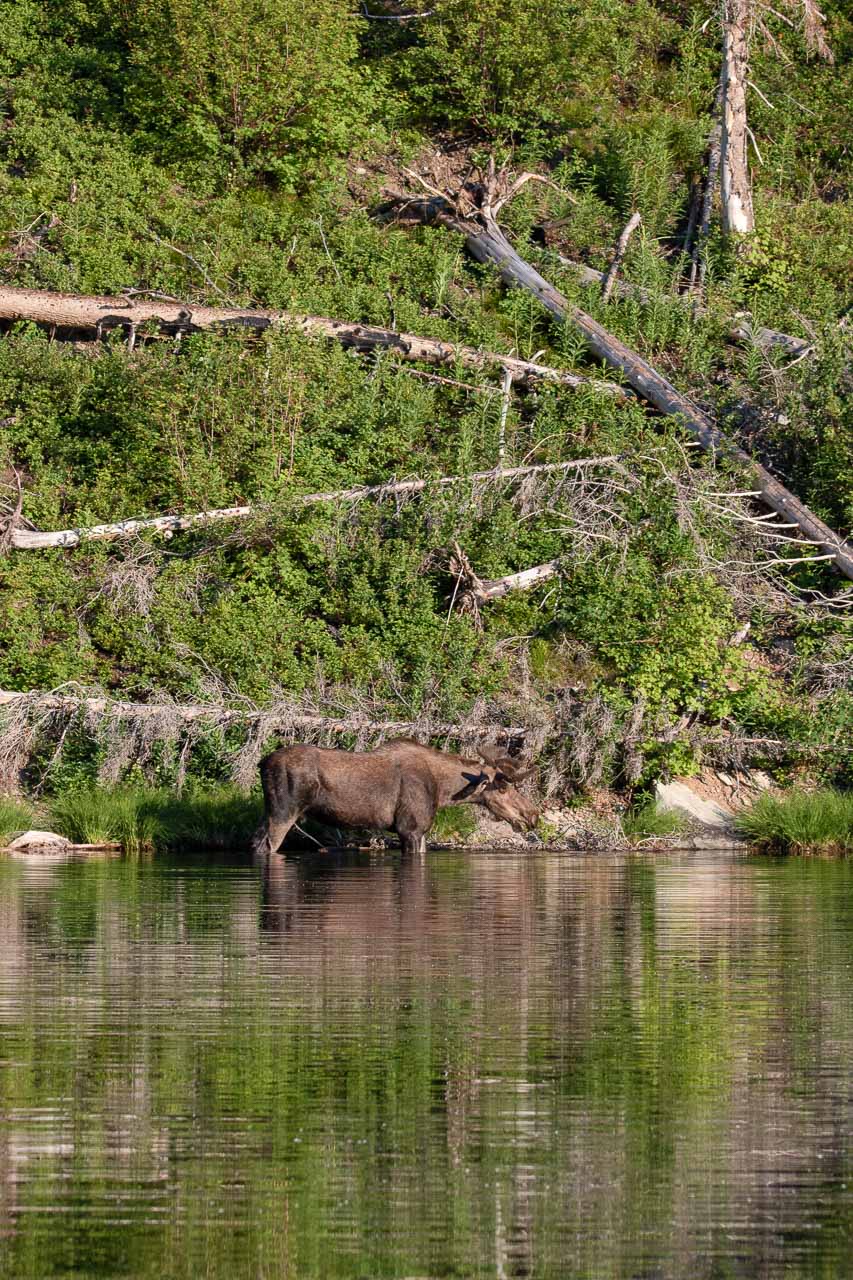
The north shore of St. Mary Lake on the park’s east side is a rather large area, which doesn’t often feature in lists of the best places to see wildlife in Glacier National Park.
However, after my visit to the park, I couldn’t not include it here, considering how many animals I saw on this 10-mile stretch of the Going-to-the-Sun Road.
Between the prairie at St. Mary Village and the Rocky Mountains foothills at Sunrift Gorge are many miles of lakeshore habitat. This includes grasslands, rocky shores, woodlands, and a number of smaller lakes and ponds.
Black bears and grizzly bears forage in the young forest that’s slowly growing back after the 2015 Reynolds Creek Fire. Because there’s little dense vegetation between Sun Point and Rising Sun, you can easily scan the slopes along the roads for bear movement.
In terms of accommodation in Glacier National Park, stay at the Rising Sun Motor Inn & Cabins for easy access to this wildlife-rich area.
If you’re lucky, you can find a moose browsing along the shoreline of little Lost Lake, which is just east of Sun Point.
Additionally, moose sometimes also swim across St. Mary Lake, one of the largest Glacier National Park lakes, which definitely is a memorable sight.
On the northern part of St. Mary Lake’s north shore, you’ll find Two Dog Flats. Several pullouts along this large sloping meadow offer you the opportunity to scout for animals.
Especially at dawn and dusk, this is a fantastic place to see some of that famous Glacier National Park wildlife. Elk are frequently seen here, while lucky (and patient) visitors might see a coyote or bear as well.
Many Glacier Road
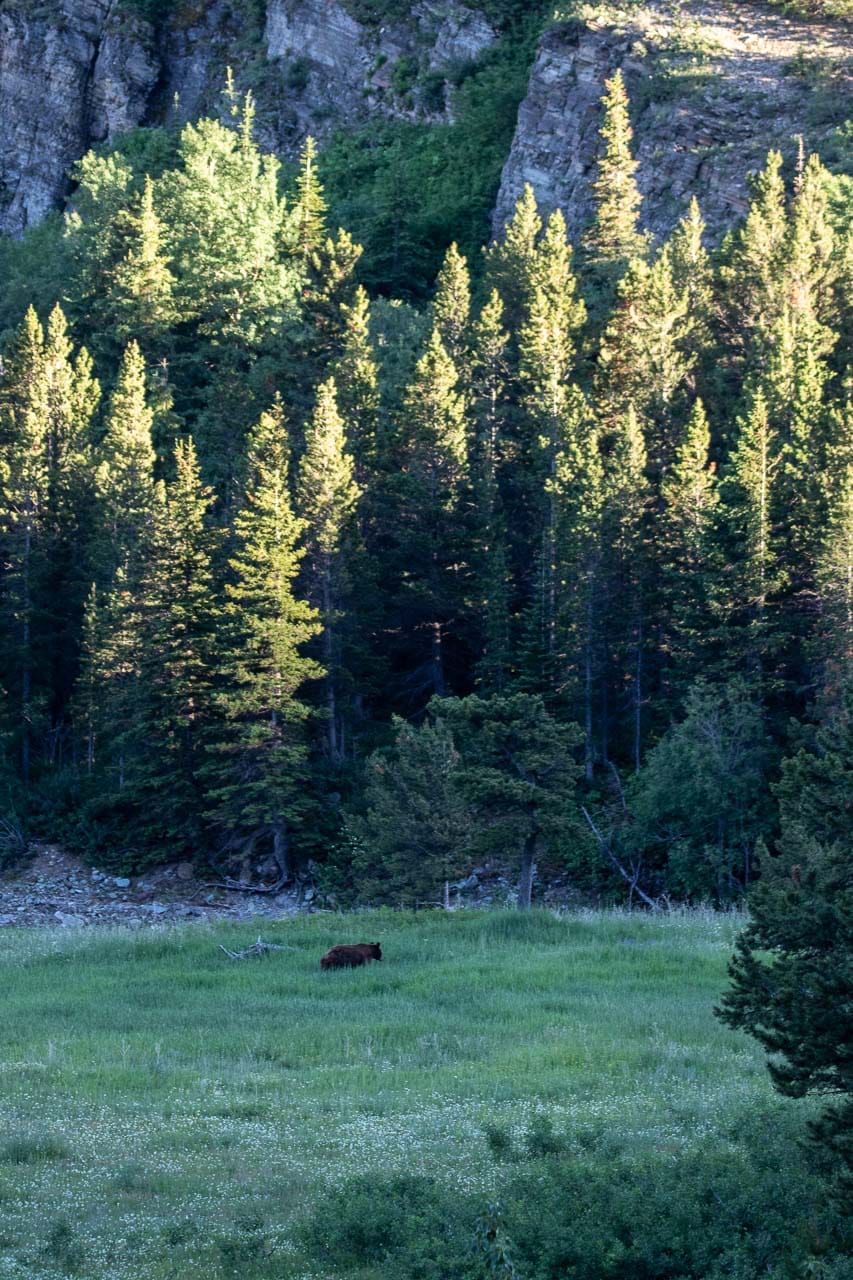
If I had to pick the easiest and best place to see wildlife in Glacier National Park, it would probably be the Many Glacier Road.
The 4.5 miles between the Many Glacier Entrance Station and Many Glacier Hotel, one of the most historic national park hotels, or Many Glacier Campground offer some of the best wildlife viewing in Glacier National Park.
About half of this drive is along the north shore of Lake Sherburne, which features expansive meadows interspersed with patches of woodland. The other half is a bit higher above the slopes below, but offers amazing views.
On one evening drive on the Many Glacier Road, I saw two grizzly bears and three black bears, just on this stretch alone. The following morning, I saw another grizzly here.
This is also a great place to see ungulates like elk and moose, as well as a variety of birds.
Many Glacier Trails
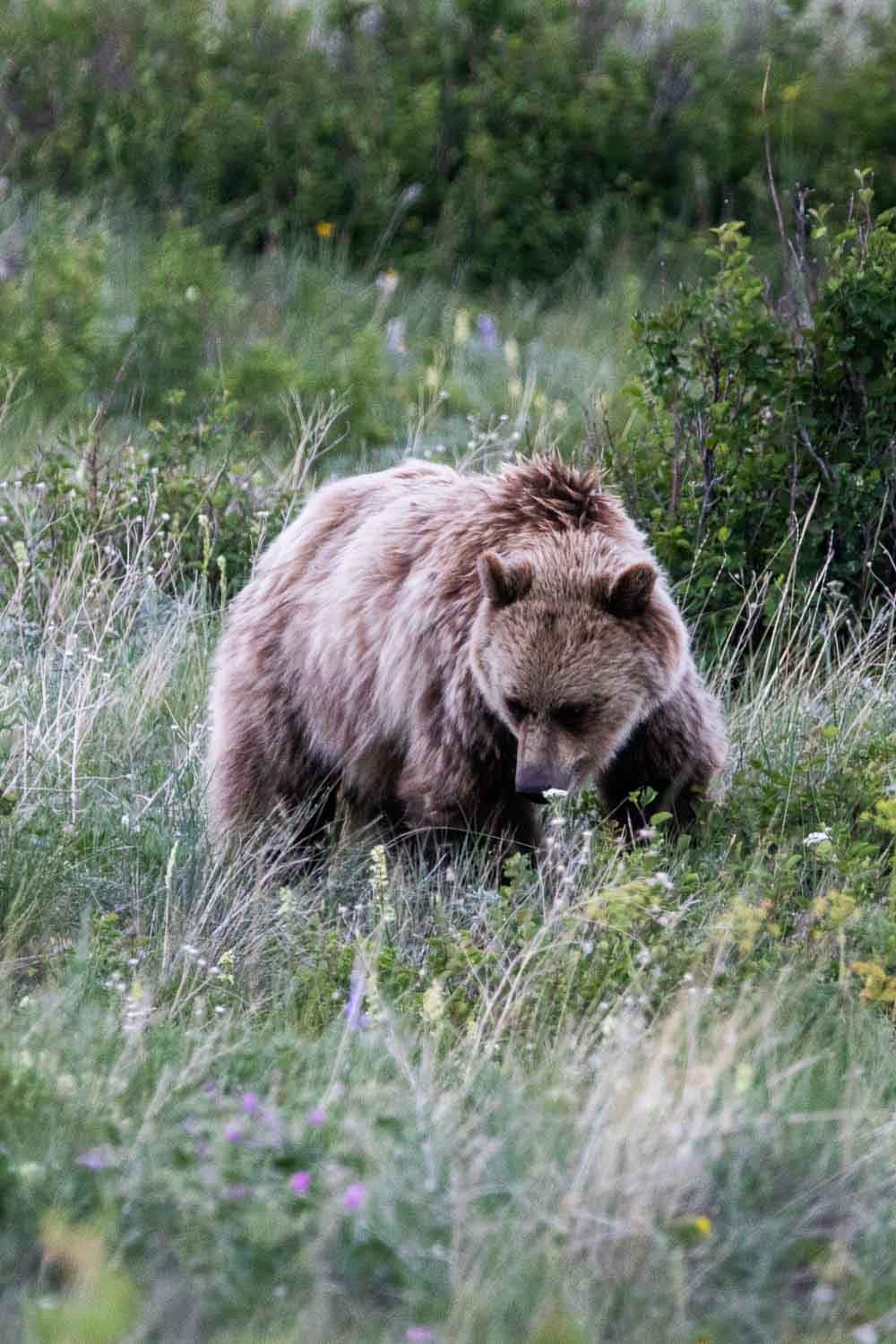
Various fantastic hiking trails radiate out from two main parking lots at Many Glacier, at or near the end of the Many Glacier Road.
From the Swiftcurrent Lake parking lot or the Many Glacier Hotel, trails lead to spectacular places like Cracker Lake, Lake Josephine, Grinnell Lake and Grinnell Glacier.
The Swiftcurrent Motor Inn parking lot or the Many Glacier Campground are where you’ll find the trailheads for hikes to famous destinations, such as Redrock Falls, Ptarmigan Falls and Tunnel, and Iceberg Lake.
All of these trails are in prime wildlife habitat. Black bears and grizzly bears abound here—the Many Glacier Valley is home to the densest concentration of bears in Glacier National Park.
This is also one of the best places to see moose in Glacier National Park, particularly on the shores of Swiftcurrent Lake, Fishercap Lake and Bullhead Lake.
Therefore, it is essential that you know how to behave when encountering wildlife in Glacier National Park up-close. This knowledge could quite literally save your life.
Everyone would like to see bears, moose and other animals in the wild, but hardly anyone wants to surprise one of those large mammals at close range.
You should carry bear spray at all times when out and about in Glacier National Park. Have it easily accessible—not in your backpack—and make sure you know how and when to use it. You can read how to use bear spray correctly here.
Wildlife Safety in Glacier National Park
In order to make Glacier National Park wildlife viewing a positive experience for all parties involved, both people and the animals, always follow the park’s guidelines and use common sense.
Park rules require that you stay at least 300 feet (100 yards) away from wolves, black bears and grizzly bears.
You must also stay at least 75 feet (25 yards) away from all other wildlife in Glacier National Park, including bighorn sheep, mountain goats, elk, deer, moose and marmots.
Essential Gear for Wildlife Photography / Viewing in Glacier National Park
I recommend that you read all these wildlife safety guides to prepare for your visit to Glacier National Park. Watching wildlife in Glacier is a unique experience, one that you’ll hopefully remember for the rest of your life.
Map of the Best Places to See Wildlife in Glacier National Park
This map offers a visual overview of the locations of the best wildlife viewing areas in Glacier National Park.
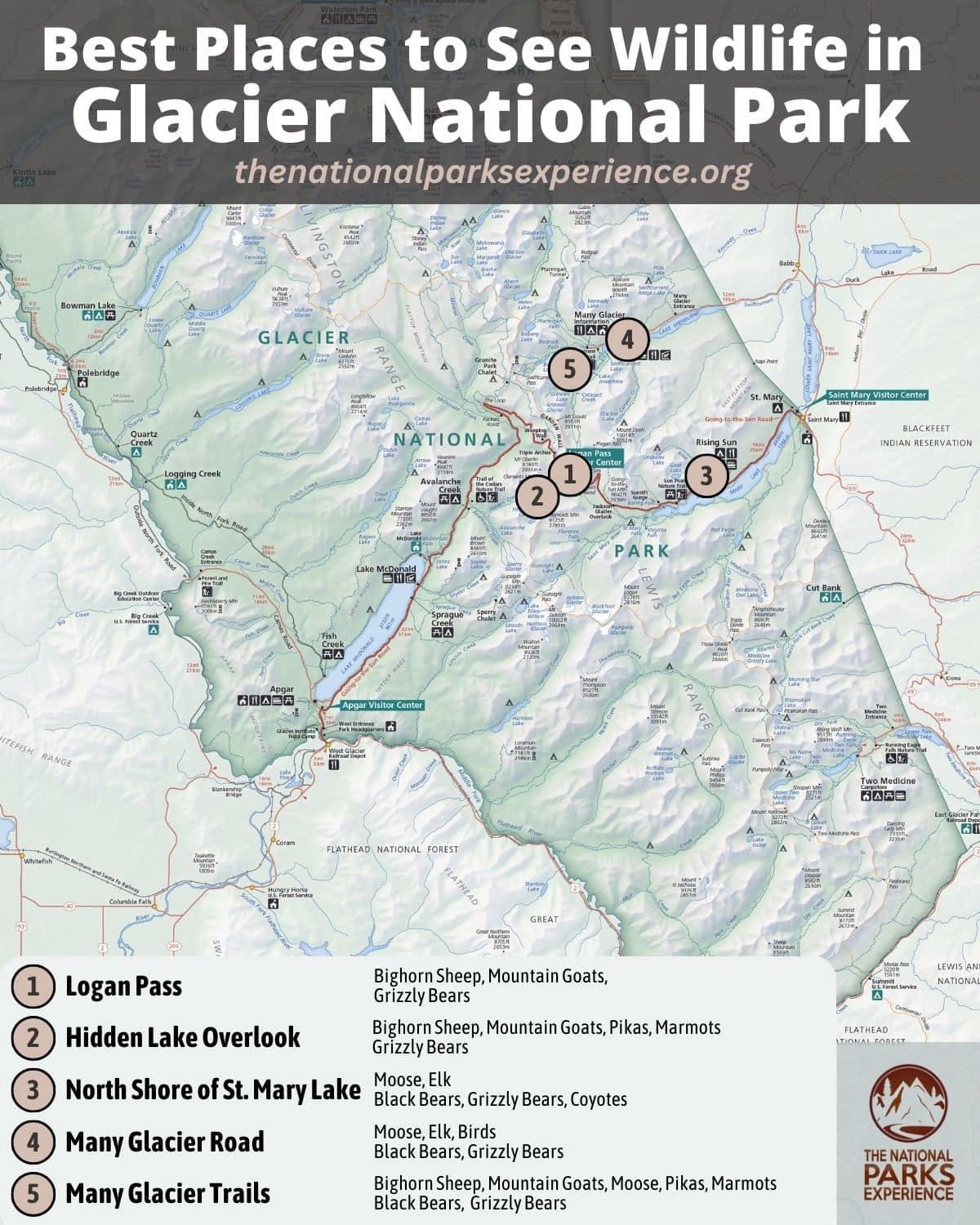
Recommended Glacier National Park Books
- Glacier National Park: Hiking, Camping, Lakes & Peaks (Travel Guide) – Moon / Becky Lomax
- The Father of Glacier National Park: Discoveries and Explorations In His Own Words – George Bird Grinnell
- Rangers, Trappers and Trailblazers: Early Adventures in Montana’s Bob Marshall Wilderness and Glacier National Park – John Fraley
- Death in Glacier National Park: Stories of Accidents and Foolhardiness in the Crown of the Continent – Randi Minetor

